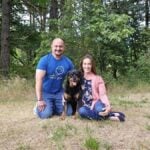


Home » Measuring Progress by Using the Power of Observation

Today’s exhibitors choose to show dogs for a variety of reasons. Most enjoy spending time with their two- and four-legged friends doing something that’s fun for everyone. Many have specific goals in mind and endeavor to achieve them as schedules and budgets allow, and some are serious competitors who collect points and chase ratings. Others are breeders who show their dogs to get the nod from well-respected judges and another look from ringside audiences. This last point was emphasized recently when I noticed my attention being drawn to several dogs at an all-breed event and wondered why they were able to hold my attention. The experience, I think, has something to do with the powerful understanding that results from active observation.
At every show that I attend, I hope to fall in love with a dog. While walking from ring to ring or through the grooming area, I anticipate an encounter that stops me in my tracks and makes my heart skip a beat. It almost always happens, and when it does I come away with a greater appreciation for the dog and its breed. At a show I attended last month, I encountered not one but four dogs that worked their magic by allowing me to observe their many fine qualities. I didn’t go looking for them specifically, they were simply “there” and I couldn’t help but appreciate them. Each experience gave me an opportunity to make some progress in my understanding of their breeds.
The first dog I encountered was a hound of an exceedingly rare breed that is not often seen at dog shows. This particular animal caught my eye in the Group line-up due to her balance and proportions, and her feet, which were as beautiful as they were functional. When she moved, she held her form and looked even better. There was power and ease in every step she took, and she held her head and tail as hoped. When I moved my position so that I could see her down and back, the view did not disappoint. In fact, from any angle this girl “looked the part.” Eventually, I took note of the person on the other end of the lead and realized how masterfully she had gone unnoticed. The handler simply allowed her hound’s many fine qualities to be seen. When the judge made a cut, the pair was pulled and ultimately received a well-deserved Group placement.
Later that afternoon, I was standing around the Group ring when a handler placed a damp beach towel at my feet. After we’d exchanged small talk, the handler’s assistant arrived with a dog that would be competing in the next Group. That dog, a top winner with an enviable show record, stood mere inches from me. The adjacency gave me the same perspective that the Working Group judge would soon have, and I took advantage of the moment. I found myself studying the dog, his head characteristics and his neck into shoulder transition. I took note of his short back and breadth of loin, and I was mesmerized by the condition of his coat. I wanted so badly to get my hands on him but was nevertheless satisfied with the visual cues I was receiving. What surprised me was how I could actually feel the dog’s power and energy. From my vantage point, he wasn’t merely parts and pieces worthy of a second look, he was a spirit ready to take flight. The Group that day was ultimately his.
The next two dogs to captivate me that afternoon were Toys. I’d happened to watch both dogs in their Breed ring and wanted to see how they’d stack up in the Group. The first was a drop-coated dog I’d noticed in the Best of Breed line-up. He was third or fourth in line, but it seemed like he was the only dog in the ring. While his competition was being groomed frantically by exhibitors who were down on their knees, wildly brushing to get every hair in place, this dog simply stood there. His coat was somehow already flawless, and he looked like a piece of porcelain. He moved only his head, casually and in the direction of the audience, creating the breed’s classic image that appears in win photos; the dog’s body in profile, with a gorgeous head facing the camera. As I enjoyed the view, I took note of the exhibitor who stood facing her dog at a meter’s distance. The presentation was a study in stillness, and the dog was pulled in the Group but did not place.
The second Toy dog to capture my attention that afternoon triumphed in a very large Breed entry. This particular breed is a colorful character, but most of the exhibits on the day were all similarly hued. Initially, I was taken by the subtle shadings of the eventual winner’s coat, but it was his expression and his animation that sustained my interest. In this ring, all of the exhibitors seemed as excited as their dogs, gesticulating rhythmically in an effort to maintain their dogs’ attention. This dog, however, was a busybody with focus. He simply stared at the exhibitor who knelt mere inches in front of him. From several yards away, the tension between the two was palpable, and for a moment it seemed as though the dog’s handler was going to collapse under the pressure. When the judge finally pointed in the pair’s direction, relief could be seen on the handler’s face – followed by tears of joy. The touching scene was later repeated when the pair made it out of the Group and all the way to Best in Show where they were surpassed only by the spirited Working dog.
Moments like these happen at every dog show, but with so much going on simultaneously it can be easy to miss the really good stuff. Those “great moments” can easily go unnoticed and once they’re gone, they’re gone forever. By taking time to look around once in a while, opportunities for learning can present themselves unexpectedly. And with each pause we can measure the progress we’ve made in our understanding of a breed, and how well we’ve fine-tuned that all-important “eye for a dog.”
